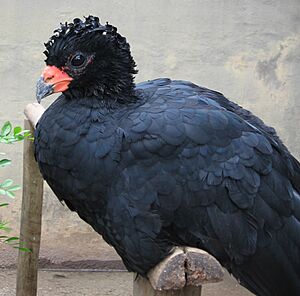Red-billed curassow facts for kids
Quick facts for kids Red-billed curassow |
|
|---|---|
 |
|
| Male | |
| Conservation status | |
| Scientific classification | |
| Genus: |
Crax
|
| Species: |
blumenbachii
|
 |
|
The red-billed curassow (Crax blumenbachii) is a special bird found only in southeastern Brazil. It lives in the Atlantic Forest, especially in the states of Espírito Santo, Bahia, and Minas Gerais. This bird is known for its bright red bill, especially in the male.
Sadly, the red-billed curassow is an endangered species. This means there are not many left in the wild. Its numbers are shrinking because of hunting and deforestation, which is when forests are cut down. Scientists are working to help this bird. They are even reintroducing some birds raised in zoos back into the wild in Rio de Janeiro.
Contents
What Does a Red-Billed Curassow Look Like?
The red-billed curassow is a big bird. It can grow to be about 82 to 92 centimeters (32 to 36 inches) long.
Male Curassow Features
The male curassow is mostly black. It has a large black crest on its head. Its belly is white. The most striking part is its bill, which has bright red bumps and fleshy parts called wattles at the base. This red bill is how the bird got its name!
Female Curassow Features
Female red-billed curassows look a bit different. They do not have the red wattles on their bills. Their upper body is black. Their crest is black and white with stripes. Their wings are reddish-brown with black stripes and spots. Their undersides are also reddish-brown.
How Red-Billed Curassows Live
Red-billed curassows spend most of their time on the ground. They walk around looking for food.
What Do They Eat?
These birds eat many things they find on the forest floor. Their diet includes seeds, fruits, and buds from plants. They also eat small bugs and other tiny creatures.
Reproduction and Life Cycle
Male curassows make loud "booming" sounds. They usually do this in September and October. This is part of how they attract mates. Female curassows lay one to four eggs at a time. The young birds are usually ready to fly by the end of the year.
Why Are They Endangered?
The red-billed curassow lives in a very small area in eastern Brazil. Their numbers are going down for a few main reasons.
Habitat Loss
The forests where these birds live are being cut down. People are turning the land into farms and plantations. This means the curassows lose their homes. Now, they mostly live in special protected areas called reserves.
Threats from Humans
Even in reserves, the birds are still in danger. People sometimes hunt them illegally. They are also caught and sold in the bird trade. These activities make it harder for the curassow population to grow.
Conservation Efforts
Good news! There have been successful programs to breed these birds in captivity. This means scientists are raising them in safe places like zoos. The goal is to release them back into the wild to help their numbers grow. The International Union for Conservation of Nature (IUCN) lists the red-billed curassow as "endangered." This shows how important it is to protect them.


